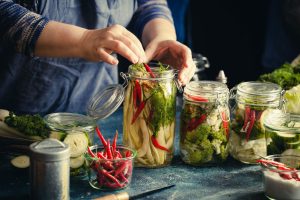
Preservatives, both natural and synthetic, prevent food spoilage and prolong the shelf life of products. They also slow down the oxidation process that turns fats rancid.
Humans have always preserved foods for survival purposes by drying, salting, and freezing them. Antioxidants are a group of chemicals that delay the deterioration of food ingredients and food products. They can be natural or synthetic. They function by preventing oxidation reactions, which cause rancid off-flavors and aromas, loss of food color, textural changes, and nutritional losses. They do this by scavenging and intercepting free radicals, chelating metal ions or breaking down the chain reaction of oxidation. Examples of antioxidants used in foods are rosemary extract, nisin (E234), propyl gallate, ascorbic acid, tocopherols, and erythorbic acid.
These chemical compounds are used in the food industry widely, as they are less reactive than natural preservatives and offer higher performance levels and better stability compared to their synthetic counterparts. However, consumer preference for naturally derived products is driving some companies to remove synthetic antioxidants from their products such as cereals.
Food preservatives that inhibit the growth of pathogenic or spoilage microorganisms in food can prevent contaminated foods from becoming a health hazard to consumers. These chemicals are often used along with other preservation methods to prolong the useful life of foods.
The Food Preservatives Market is driven by the increasing demand for packaged food by the growing population and propelling urbanization in the Asia Pacific. Synthetic food preservatives are dominating the market due to their cost-effectiveness and wide applicability, but there is a growing trend toward natural and clean-label alternatives.
Traditional chemical preservatives include sodium chloride, organic acids such as acetic, benzoic, and propionic acid, nitrates and nitrites, and sulfur dioxide. Antimicrobials such as bacteriocins and essential oils can also serve as natural food preservatives.
Other types of food preservatives are designed to block oxidation or stop the enzymes that cause foods to spoil or develop an off-flavor. They may be naturally occurring or synthetic. These preservatives are used by manufacturers to maintain the flavor and texture of packaged foods and to control contamination that can lead to foodborne illness or other problems.
For centuries, people have used natural preservatives such as salt, honey, and certain fruits to prevent foods from spoiling. These preservatives suppress mold growth, bad odors, and undesirable chemical changes. Food manufacturers use both natural and synthetic chemicals to keep products from going bad.
These chemicals are grouped into three general categories: antimicrobials that prevent the growth of bacteria, mold, and yeast; antioxidants that slow the oxidation of fats and lipids that leads to rancidity; and chelating agents that bind to metal ions. Preservatives are also used to change the acid-base balance of a product to get a specific flavor or color.
As consumers grow more health conscious, demand for naturally sourced flavor enhancers is rising.
Food preservation is one of the oldest technologies. Early cultures dried, salted, and even smoked foods to ensure their survival in times of need. Food manufacturers use physical and chemical preservation methods to keep their products fresh for longer periods of time.
While there are many ways to Food Preservatives the two most common include refrigeration and chemical preservatives. Refrigeration slows down degradation caused by microorganisms, which helps extend the shelf life of the food product. Chemical preservatives inhibit spoilage by stopping the growth of bacteria, fungi and molds.
They also prevent changes in color, texture, and flavor and delay rancidity. Preservatives are widely used in makeup, pharmaceuticals, and cleaning products to fight contamination by harmful bacteria. They are also found in medications such as acetaminophen and insulin. The two main types of preservatives are antimicrobials that prevent the growth of bacteria, molds, or yeasts and antioxidants that stop the oxidation of fats and lipids that causes rancidity.



